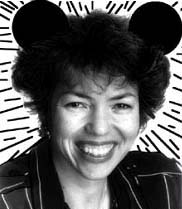The
Label Project
How
It Works
Students become art critics
in The Label Project.
1. They meet museum curators and gallery directors to learn
about the process of writing interpretive essays and descriptive labels for artwork in exhibits to the public.
2. To pre-plan for The
Label
Project the teacher contacts a gallery or museum's education department to
discuss upcoming exhibits or collections that might be of interest to her class, subject etc. Meryl Meisler worked with the New Museum of Contemporary
Art and the Dia Art Foundation to prepare for The Label Project.
3. Teacher makes a pre-visit
(if possible in person or by phone) to discuss the goals of the class and to
preview works on display.
4. The teacher gets samples
of labels on commercial products as well as from gallery or museum catalogues.
The students who
participated in this model project, met with the Curatorial staff of The New
Museum of Contemporary Art and the Education Director of the Dia Art Foundation
in NYC. As a culmination to the unit, the students wrote the labels that were
installed next to the original art work at the New Museum’s "Time of Our
Lives" exhibit.
Prior to meeting with curators, activities include:
1. "Dissecting"
labels on consumer products. Students collect samples of labels (cans, jars,
boxes, clothing etc.) The class uses web mapping on the board to identify common elements on the labels: title and/or
description of product, manufacturer, date and place of production,
ingredients, weight and/or size, graphic element, and sometimes the price.
2. Students view examples of
labels on artwork from museums or galleries. They discuss elements that are
common to labels on commercial products such as:
Title of product = title of
artwork,
manufacturer = artist,
ingredients = materials used,
date of manufacture
or copyright = when artwork was completed and possibly the birth date of the
artist,
graphic element = the artwork itself,
place of manufacture = artist's
culture or nationality, description = narrative by curator about work on
display.
3. Students create
self-portraits of themselves as labels. They decide what information they want
to include on the self-portrait and what type of imaginary commercial product
they will use to represent themselves. Students take on the role of commercial
artist and the teacher becomes the art director. In a series of homework
assignments that are presented to the class student create thumbnail drawings,
rough sketches, and comprehensive drawings of the self-portrait label. Students
critique each other's work.
4. The students go on a trip
to see at least two museums or galleries. Generate a list of questions the
students might use to help them interpret the work such as: What do you think
the artist was trying to convey in the work? How does the work fit into the
theme of the exhibit? Why do you think the curator chose this piece? If
possible, arrange to meet a docent, curator or representative of the education
department to discuss with the class how decisions are made on what information
to present to the public in the form of labels and catalogues.
5. The students choose at
least two works to write their own labels about. They take notes at the exhibit
describing their interpretations of the work.
6. Back at school, students
read their interpretations out loud. They rewrite and word-process their final
versions of their labels.
7. Students
e-mail or snail
mail their labels to gallery or museum person they met with.
8. Students create an online
gallery and or bulletin board about their The Label Project. They exhibit their self-portraits
as labels and samples of their critical writing.
Standards
Creating, Performing, and Participating in the Arts-
Students will actively
engage in the processes that constitute creation and performance in the arts
and participate in various roles in the arts.
Responding to and
Analyzing Works of Art-
Students will respond
critically to a variety of works in the arts, connecting the individual work to
other works and to aspects of human endeavor and thought.
What
You Need
Software Materials Used:
Software: digital imaging
and word processing software (e.g. PhotoShop, AppleWorks, Microsoft Word),
Internet connection and email, scanner and digital camera.
The
Students
heterogeneously mixed,
multi-racial, multi-ethnic grades 10 & 11 students in NYC
Overall
Students become active
participants in the arts as creators, critics, and curators. They become aware
of importance of developing critical thinking and writing skills for careers in
the arts and related fields. They learn how to "read" and communicate
their interpretions of art work.
Tips:
Funding
for museums and not-for-profit galleries are often contingent on their work
with the general public. They need to educate the general public in order to
thrive and create an audience of viewers and collectors. They need you. Don't
be afraid to contact them.
|

Meryl Meisler, a NYC Public
School Art Educator since 1979, teaches digital art at The Institute for Collaborative Education
(a small 6-12 school). Among her
career highlights are inclusion of her students' collaborative work in the
Whitney Museum Biennial, the Queens Hall of Science collection, and
several exhibits at the New Museum of Contemporary
Art. Meryl's own multimedia
artwork has been widely exhibited internationally; her solo
show at Grand Central Terminal was featured in WIRED magazine. She is the
recipient of numerous grants and awards including the Council of Basic
Education-Time Warner Inc. Art Fellowship, Disney
American Teacher Award,
Japan Society Travel/Study in Japan, NY Foundation
for the Arts Fellowship, a
Brooklyn Borough President Proclamation, Artists Space Individual Artists
Grant, Chase Active Learning Grant, IMPACT II Developer Grant. Earthwatch
Education Award, Samuels Award for Excellence in
Teaching, and
C.E.T.A.
Artists Grant (the "WPA of the '70s"). Meryl is a member on the Teachers Network Board of Directors.
meryl@teachersnetwork.org
|